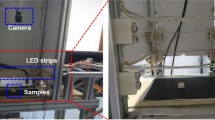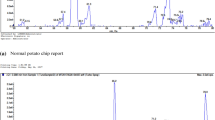Abstract
Due to the severe hazard of traces of harmful substances in flour and its massive production, pretreatment-free, rapid, and accurate determination of trace harmful substances was a practical and urgent demand in modern daily life. In this study, multi-molecular infrared (MM-IR), consisting of one-dimensional infrared (1D-IR), synchronous and asynchronous two-trace two-dimensional correlation infrared (2T-2DCOS-IR), as well as their RGB IR-image, was developed and employed to directly identify flour with diverse harmful substances. The present findings indicated that 2T-2DCOS analysis based on asynchronous pictures was better than others at identifying target substances and shedding new light on previous MM-IR-related studies. Systematical comparison of developed MM-IR-AlexNet flour models with conventional machine learning algorithms indicated that asynchronous MM-IR-AlexNet (2T-2DCOS-IR-AlexNet) had the best performance with 99.6% accuracy. Therefore, it was demonstrated that deep learning-based MM-IR could be a robust method for the direct detection of trace harmful substances in power foods.





Similar content being viewed by others
Data Availability
The data used in this study are available from the corresponding author upon reasonable request.
References
Aaron, J. S., Taylor, A. B., & Chew, T. L. (2018). Image co-localization - co-occurrence versus correlation. Journal of Cell Science, 131(3), 10. https://doi.org/10.1242/jcs.211847
Altomare, C., Logrieco, A. F., & Gallo, A. (2021) Mycotoxins and mycotoxigenic fungi: Risk and management. A challenge for future global food safety and security. In: Zaragoza, Ó., & Casadevall, A. (eds) Encyclopedia of Mycology. pp 64–93. Elsevier, Oxford. https://doi.org/10.1016/B978-0-12-819990-9.00032-9
Benmouna, B., Garcia-Mateos, G., Sabzi, S., Fernandez-Beltran, R., Parras-Burgos, D., & Molina-Martinez, J. M. (2022). Convolutional neural networks for estimating the ripening state of Fuji apples using visible and near-infrared spectroscopy. Food and Bioprocess Technolgy, 15(10), 2226–2236. https://doi.org/10.1007/s11947-022-02880-7
Chang, C. C., & Lin, C. J. (2011). LIBSVM: A library for support vector machines. Acm Transactions on Intelligent Systems and Technology, 2(3), 27. https://doi.org/10.1145/1961189.1961199
Ghazi, M. M., Yanikoglu, B., & Aptoula, E. (2017). Plant identification using deep neural networks via optimization of transfer learning parameters. Neurocomputing, 235, 228–235. https://doi.org/10.1016/j.neucom.2017.01.018
Guan, W. B., You, Y. X., Li, J. L., Hong, J. Y., Wu, H. Y., & Rao, Y. N. (2020). Penicillic acid in fruits: Method development, validation by liquid chromatography-tandem mass spectrometry and survey in southern China. Journal of the Science of Food and Agriculture. https://doi.org/10.1002/jsfa.10906
Guo, X. X., Hu, W., Liu, Y., Gu, D. C., Sun, S. Q., Xu, C. H., & Wang, X. C. (2015). Rapid analysis and quantification of fluorescent brighteners in wheat flour by tri-step infrared spectroscopy and computer vision technology. Journal of Molecular Structure, 1099, 393–398. https://doi.org/10.1016/j.molstruc.2015.06.081
Guo, X. X., Hu, W., Liu, Y., Sun, S. Q., Gu, D. C., He, H. L., Xu, C. H., & Wang, X. C. (2016). Rapid determination and chemical change tracking of benzoyl peroxide in wheat flour by multi-step IR macro-fingerprinting. Spectrochimica Acta Part a-Molecular and Biomolecular Spectroscopy, 154, 123–129. https://doi.org/10.1016/j.saa.2015.10.017
Hauke, J., & Kossowski, T. (2011). Comparison of values of Pearson’s and Spearman’s correlation coefficients on the same sets of data. Quaestiones Geographicae, 30(2), 87–93. https://doi.org/10.2478/v10117-011-0021-1
Huang, Y. Q., Kangas, L. J., & Rasco, B. A. (2007). Applications of artificial neural networks (ANNs) in food science. Critical Reviews in Food Science and Nutrition, 47(2), 113–126. https://doi.org/10.1080/10408390600626453
Icelli, O., Oz, E., Bakirdere, S., & Nuroglu, E. (2020). Analysis of conventionally and magnetic-field dried fruit and nuts for mycotoxins by high-performance liquid chromatography-tandem mass spectrometry (HPLC-MS/MS) and trace elements by inductively coupled plasma-mass spectrometry (ICP-MS). Analytical Letters, 53(5), 735–745. https://doi.org/10.1080/00032719.2019.1669630
Kim, G., Lee, H., Baek, I., Cho, B. K., & Kim, M. S. (2022). Quantitative detection of benzoyl peroxide in wheat flour using line-scan short-wave infrared hyperspectral imaging. Sensors and Actuators B-Chemical, 352, 7. https://doi.org/10.1016/j.snb.2021.130997
Li, F. L., Xie, J., Wang, S., Wang, Y., & Xu, C. H. (2021). Direct qualitative and quantitative determination methodology for massive screening of DON in wheat flour based on multi-molecular infrared spectroscopy (MM-IR) with 2T–2DCOS. Talanta, 234, 122653. https://doi.org/10.1016/j.talanta.2021.122653
Lin, P., Li, X. L., Chen, Y. M., & He, Y. (2018). A deep convolutional neural network architecture for boosting image discrimination accuracy of rice species. Food and Bioprocess Technolgy, 11(4), 765–773. https://doi.org/10.1007/s11947-017-2050-9
Liu, S., Wei, W., Bai, Z., Wang, X., Li, X., Wang, C., Liu, X., Liu, Y., & Xu, C. (2018). Rapid identification of pearl powder from Hyriopsis cumingii by tri-step infrared spectroscopy combined with computer vision technology. Spectrochim Acta A Mol Biomol Spectrosc, 189, 265–274. https://doi.org/10.1016/j.saa.2017.08.031
Minaee, S., Abdolrashidi, A., Wang, Y., & Ieee. (2016). An experimental study of deep convolutional features for iris recognition. In: IEEE Signal Processing in Medicine and Biology Symposium, Temple Univ, Sci Educ & Res Ctr, Philadelphia, PA, Dec 03 2016. IEEE Signal Processing in Medicine and Biology Symposium. IEEE, NEW YORK. https://doi.org/10.1109/spmb.2016.7846859
Mitema, A., Feto, N. A., & Rafudeen, M. S. (2020). Development and validation of TOF/Q-TOF MS/MS, HPLC method and in vitro bio-strategy for aflatoxin mitigation. Food Additives and Contaminants Part a-Chemistry Analysis Control Exposure & Risk Assessment, 37(12), 2149–2164. https://doi.org/10.1080/19440049.2020.1815861
Noda, I. (2018). Two-trace two-dimensional (2T2D) correlation spectroscopy – A method for extracting useful information from a pair of spectra. Journal of Molecular Structure, 1160, 471–478. https://doi.org/10.1016/j.molstruc.2018.01.091
Noda, I. (2020). Closer examination of two-trace two-dimensional (2T2D) correlation spectroscopy. Journal of Molecular Structure. https://doi.org/10.1016/j.molstruc.2020.128194
Nualkaw, K., Poapolathep, S., Zhang, Z. W., Zhang, Q., Giorgi, M., Li, P. W., Logrieco, A. F., & Poapolathep, A. (2020). Simultaneous determination of multiple mycotoxins in swine, poultry and dairy feeds using ultra high performance liquid chromatography-tandem mass spectrometry. Toxins, 12(4), 18. https://doi.org/10.3390/toxins12040253
Oztekin, N., Aydin, H. M., & Erim, F. B. (2009). Stacking in CE for analysis of bromate flour additive. Chromatographia, 70(5–6), 987–990. https://doi.org/10.1365/s10337-009-1250-5
Pan, Q. N., Xie, J., Lin, L., Hong, M. S., Wang, X. C., Sun, S. Q., & Xu, C. H. (2020). Direct identification and quantitation of fluorescent whitening agent in wheat flour based on multi-molecular infrared (MM-IR) spectroscopy and stereomicroscopy. Spectrochimica Acta Part a: Molecular and Biomolecular Spectroscopy. https://doi.org/10.1016/j.saa.2020.119353
Ran, R., Wang, C. H., Han, Z., Wu, A. B., Zhang, D. B., & Shi, J. X. (2013). Determination of deoxynivalenol (DON) and its derivatives: Current status of analytical methods. Food Control, 34(1), 138–148. https://doi.org/10.1016/j.foodcont.2013.04.026
Sadhasivam, S., Britzi, M., Zakin, V., Kostyukovsky, M., Trostanetsky, A., Quinn, E., & Sionov, E. (2017) Rapid detection and identification of mycotoxigenic fungi and mycotoxins in stored wheat grain. Toxins (Basel). 9(10). https://doi.org/10.3390/toxins9100302
Sudirman, W., & A. P., & Wanto, A. (2018). Data mining tools | rapidminer: K-means method on clustering of rice crops by province as efforts to stabilize food crops in Indonesia. IOP Conference Series: Materials Science and Engineering, 420, 012089. https://doi.org/10.1088/1757-899x/420/1/012089
Wang, S., Hu, X. Z., Liu, Y. Y., Tao, N. P., Lu, Y., Wang, X. C., Lam, W., Lin, L., & Xu, C. H. (2022). Direct authentication and composition quantitation of red wines based on tri-step infrared spectroscopy and multivariate data fusion. Food Chemistry, 372, 131259. https://doi.org/10.1016/j.foodchem.2021.131259
Wang, X. B., Huang, W. Q., Zhao, C. J., Wang, Q. Y., Liu, C., & Yang, G. Y. (2017). Quantitative analysis of BPO additive in flour via Raman hyperspectral imaging technology. European Food Research and Technology, 243(12), 2265–2273. https://doi.org/10.1007/s00217-017-2928-9
Xie, J., Pan, Q., Li, F., Tang, Y., Hou, S., & Xu, C. (2021). Simultaneous detection of trace adulterants in food based on multi-molecular infrared (MM-IR) spectroscopy. Talanta, 222, 121325. https://doi.org/10.1016/j.talanta.2020.121325
Yang, R., Liu, R., Dong, G., Xu, K., Yang, Y., & Zhang, W. (2016). Two-dimensional hetero-spectral mid-infrared and near-infrared correlation spectroscopy for discrimination adulterated milk. Spectrochim Acta A Mol Biomol Spectrosc, 157, 50–54. https://doi.org/10.1016/j.saa.2015.12.017
Yang, R. J., Liu, C. Y., Yang, Y. R., Wu, H. Y., Jin, H., Shan, H. Y., & Liu, H. X. (2020). Two-trace two-dimensional(2T2D) correlation spectroscopy application in food safety: A review. Journal of Molecular Structure, 1214, 8. https://doi.org/10.1016/j.molstruc.2020.128219
Zhang, J., Yin, H. L., Samuel, B., Liu, F., & Chen, H. H. (2018). A novel method of three-dimensional hetero-spectral correlation analysis for the fingerprint identification of humic acid functional groups for hexavalent chromium retention. Rsc Advances, 8(7), 3522–3529. https://doi.org/10.1039/c7ra12146f
Zhang, X., Li, Y., Tao, Y., Wang, Y., Xu, C., & Lu, Y. (2021a). A novel method based on infrared spectroscopic inception-resnet networks for the detection of the major fish allergen parvalbumin. Food Chemistry, 337, 127986. https://doi.org/10.1016/j.foodchem.2020.127986
Zhang, X. L., Yang, J., Lin, T., & Ying, Y. B. (2021b). Food and agro-product quality evaluation based on spectroscopy and deep learning: A review. Trends in Food Science & Technology, 112, 431–441. https://doi.org/10.1016/j.tifs.2021.04.008
Zhou, L., Wang, X. F., Zhang, C., Zhao, N., Taha, M. F., He, Y., & Qiu, Z. J. (2022). Powdery food identification using NIR spectroscopy and extensible deep learning model. Food and Bioprocess Technolgy, 15(10), 2354–2362. https://doi.org/10.1007/s11947-022-02866-5
Zhu, L., Yan, Y., Gu, D. C., Lu, Y., Gan, J. H., Tao, N. P., Wang, X. C., & Xu, C. H. (2018). Rapid quality discrimination and amino nitrogen quantitative evaluation of soy sauces by tri-step IR and E-nose. Food Analytical Methods, 11(11), 3201–3210. https://doi.org/10.1007/s12161-018-1284-0
Funding
This work is financially supported by the 2022 Shanghai Grain and Material Reserve Science and Technology Innovation Research Project.
Author information
Authors and Affiliations
Contributions
Xiao-Wen Lin: conceptualization, investigation, data curation, and writing—original draft. Fei-Li Li: conceptualization, investigation, and writing—original draft. Song Wang: conceptualization, data curation, and writing—original draft. Jun Xie: conceptualization and data curation. Qian-Nan Pan: conceptualization and data curation. Ping Wang: conceptualization, supervision, and project administration. Chang-Hua Xu: conceptualization, writing—review and editing, supervision, and project administration.
Corresponding authors
Ethics declarations
Competing Interests
The authors declare no competing interests.
Additional information
Publisher's Note
Springer Nature remains neutral with regard to jurisdictional claims in published maps and institutional affiliations.
Xiao-Wen Lin, Fei-Li Li, and Song Wang equally contributed to this study.
Highlights
• 2T-2DCOS-IR had a higher resolution and was more suitable for model building.
• The visualized process of automatically extracting features made it more interpretable.
• The prediction of the asynchronous MM-IR-AlexNet flour model was the best.
Supplementary Information
Below is the link to the electronic supplementary material.
Rights and permissions
Springer Nature or its licensor (e.g. a society or other partner) holds exclusive rights to this article under a publishing agreement with the author(s) or other rightsholder(s); author self-archiving of the accepted manuscript version of this article is solely governed by the terms of such publishing agreement and applicable law.
About this article
Cite this article
Lin, XW., Li, FL., Wang, S. et al. A Novel Method Based on Multi-Molecular Infrared (MM-IR) AlexNet for Rapid Detection of Trace Harmful Substances in Flour. Food Bioprocess Technol 16, 667–676 (2023). https://doi.org/10.1007/s11947-022-02964-4
Received:
Accepted:
Published:
Issue Date:
DOI: https://doi.org/10.1007/s11947-022-02964-4




